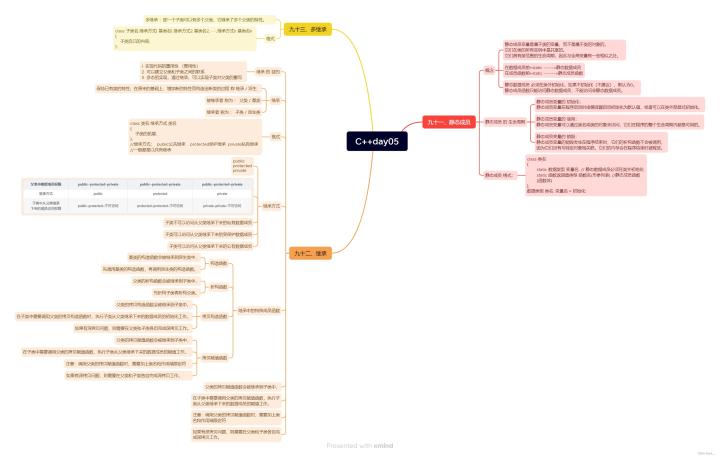- 作者:老汪软件技巧
- 发表时间:2023-12-31 03:00
- 浏览量:
九十一、静态成员
在数据成员前+ ----->静态数据成员
在成员函数前+ ------>静态成员函数
静态数据成员 必须在类外初始化,如果不初始化(不建议),默认为0。
静态成员函数只能访问静态数据成员,不能访问非静态数据成员。
91.1 静态成员 的 生命周期 91.2 静态成员 格式:
class 类名
{
static 数据类型 变量名; // 静态数据成员必须在类外初始化
static 函数返回值类型 函数名(形参列表) //静态成员函数
{函数体}
};
数据类型 类名::变量名 = 初始化;
91.3 银行账户实例
#include
using namespace std;
//封装 银行账号 类
class BankAccount
{
private:
double balance; //余额
static double interest_rate; //利率 静态数据成员
public:
//无参构造函数
BankAccount() {}
//有参构造函数
BankAccount(double m):balance(m)
{}
//静态成员函数 获取当前利率
static double getInterestRate()
{
return interest_rate;
//balance = 100; 不能访问非静态数据成员
}
//静态成员函数 设置当前利率
static void setInterestRate(double rate)
{
interest_rate = rate;
}
//静态成员函数 获取连本带利的余额
static double getLastMoney(BankAccount &account)
{
return account.balance*(1+interest_rate);
}
};
double BankAccount::interest_rate = 0.03; //静态数据成员必须在类外初始化
int main()
{
cout << BankAccount::getInterestRate() << endl;
BankAccount::setInterestRate(0.05);
cout << BankAccount::getInterestRate() << endl;
BankAccount account1(1000.0);
cout << BankAccount::getLastMoney(account1) << endl;
return 0;
}
九十二、继承 92.1 继承 的 目的 实现代码的重用性 (复用性)可以建立父类和子类之间的联系多态的实现,通过继承,可以实现子类对父类的重写 92.2 继承 92.3 格式
class 类名:继承方式 类名
{
子类的拓展;
};
//继承方式: public公共继承 protected保护继承 private私有继承
//一般都是以共有继承
92.4 继承方式 父类中数据成员权限––––––
继承方式
子类中从父类继承
下来的成员访问权限
––不可访问
––不可访问
––不可访问
92.5 继承中的特殊成员函数 92.5.1 构造函数 92.5.2 析构函数 92.5.3 拷贝构造函数 92.5.4 拷贝赋值函数
示例 :
#include
using namespace std;
// 封装 人 类 父类(基类)
class Person
{
private:
string name;
protected:
int age;
public:
int h;
public:
//无参构造
Person(){ cout << "父类的无参构造" << endl;}
//有参构造函数
Person(string n, int a, int h) :name(n),age(a),h(h)
{
cout << "父类的有参构造" << endl;
}
//拷贝构造函数
// const Person &other = other
//赋值兼容规则
//1.子类对象可以赋值给父类的对象
//2.子类对象可以初始化父类的引用
//3.父类的指针可以指向子类对象地址
Person(const Person &other):name(other.name),age(other.age),h(other.h)
{
cout << "父类的拷贝构造" << endl;
}
//拷贝赋值函数
Person &operator=(const Person &other)
{
name = other.name;
cout << "父类的拷贝赋值" << endl;
return *this;
}
//析构函数
~Person()
{
cout << "父类的析构函数" << endl;
}
void show()
{
cout << "父类" << endl;
}
};
//封装 学生类 共有继承 人 类
class Stu:public Person //子类 、派生类
{
private:
int id;
int math;
public:
Stu() {cout << "子类的无参构造函数" << endl;}
Stu(string n, int a, int h,int i, int m):Person(n,a,h),id(i),math(m)
{
cout << "子类的有参构造函数" << endl;
}
//拷贝构造函数
Stu(const Stu &other):Person(other),id(other.id),math(other.math)
//Person(other)
{
cout << "子类的拷贝构造函数" << endl;
}
Stu &operator=(const Stu &other)
{
cout << "子类的拷贝赋值函数" << endl;
id = other.id;
Person::operator=(other);
return *this;
}
~Stu()
{
cout << "子类的析构函数" << endl;
}
void show()
{
cout << "子类" << endl;
//cout << name << endl; 子类不可以访问从父类继承下来的私有数据成员
cout << age << endl; //子类可以访问从父类继承下来的受保护数据成员
cout << h << endl; //子类可以访问从父类继承下来的公有数据成员
}
};
int main()
{
Stu s1;
Stu s2("zhangsan",18,190,1001,99);
//s2.show(); //默认调用子类的show
s2.Person::show(); //调用从父类继承下来的show
Stu s3(s2); //先调用父类的拷贝构造函数,再调用子类的拷贝构造函数
s1 = s2;//先调用父类的拷贝赋值函数,再调用子类的拷贝赋值函数
return 0;
}
92.6 小结 父类的数据成员初始化必须在子类之前,先调用父类的构造函数,再调用子类的构造函数。当父类和子类出现同名同类型的函数时,不是重载,也不是重复定义,是重写,原因:作用域不同。
如果子类实例化一个对象,对象调用该函数,默认调用是子类的函数,
如果想调用父类的函数,则需要加上类名和作用域限定符。 九十三、多继承 93.1 概念 93.2 格式
class 子类名:继承方式1 基类名1,继承方式2 基类名2,······,继承方式n 基类名n
{
子类自己的内容;
};
小作业 我写的
#include
using namespace std;
class Bed{
friend class Sofa_Bed;
private:
int size;
public:
//无参构造
Bed() {cout << "床的无参构造" << endl;}
//有参构造
Bed(int size):size(size) {cout << "床的有参构造" << endl;}
//拷贝构造
Bed(const Bed &other):size(other.size) {cout << "床的拷贝构造" << endl;}
//拷贝赋值
Bed &operator=(const Bed &other){
cout << "床的拷贝赋值" << endl;
this->size = other.size;
return *this;
}
//析构函数
~Bed() {cout << "床的析构函数" << endl;}
//功能函数
void func() {cout << "能躺" << endl;}
};
class Sofa
{
friend class Sofa_Bed;
private:
int high;
public:
//无参构造
Sofa() {cout << "沙发的无参构造" << endl;}
//有参构造
Sofa(int high):high(high) {cout << "沙发的有参构造" << endl;}
//拷贝构造
Sofa(const Sofa &other):high(other.high) {cout << "沙发的拷贝构造" << endl;}
//拷贝赋值
Sofa &operator=(const Sofa &other) {
cout << "沙发的拷贝赋值函数" << endl;
this->high = other.high;
return *this;
}
//析构函数
~Sofa() {cout << "沙发的析构函数" << endl;}
//功能函数
void func() {cout << "能坐" << endl;}
};
class Sofa_Bed:protected Bed, protected Sofa
{
private:
string color;
public:
//无参构造
Sofa_Bed() {cout << "沙发床的无参构造" << endl;}
//有参构造
Sofa_Bed(string color, int size, int high):Bed(size),Sofa(high),color(color) {cout << "沙发床的有参构造" << endl;}
//拷贝构造
Sofa_Bed(const Sofa_Bed &other):Bed(other),Sofa(other),color(other.color) {cout << "沙发床的拷贝构造" << endl;}
//拷贝赋值
Sofa_Bed &operator=(const Sofa_Bed &other){
this->color = other.color;
this->Bed::operator=(other);
this->Sofa::operator=(other);
cout << "沙发床的拷贝赋值" << endl;
return *this;
}
//析构
~Sofa_Bed() {cout << "沙发床的析构函数" << endl;}
//功能
void func() {
cout << "沙发床" << endl;
this->Bed::func();
this->Sofa::func();
}
void show_info(){
cout << "大小 : " << this->Bed::size << endl;
cout << "高度 : " << this->high << endl;
cout << "颜色 : " << this->color << endl;
}
};
int main()
{
Sofa_Bed sb1;
Sofa_Bed sb2("黑色", 256, 56);
puts("");
sb2.func();
sb2.show_info();
puts("");
sb1 = Sofa_Bed("灰色", 128, 90);//调用的是拷贝赋值,将匿名对象的值拷贝赋值给sb2
puts("");
sb1.show_info();
puts("");
return 0;
}





